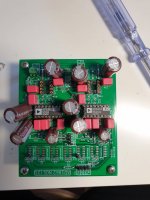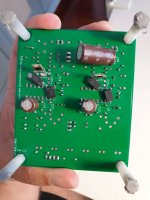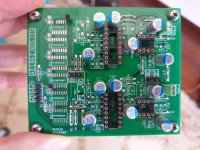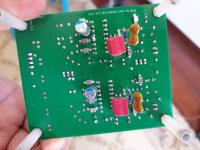perfect, we look forward to your opinion and testing ... surely try and test different opamps 🙂
Any idea about the I2S pins from the raspberry pi with the model mentioned as "Raspberry Pi (c) 2011.12". Seems like I have the older version but unable to judge that based on the pi.
Thanks
Thanks
Ok as you suggested remove both the trimmers and also the RC filters R10/11 and C37/38 and now the offset is pretty stable at 0.01mV on both the channels 🙂...
Nice work Manniraj 😉
Looks like your ready to Rock and (opamp) Roll!!
ENJOY!
@manniraj
remove the RC filter (not needed, don't put it there at all) and remove trimmers (they are not for offset)
... measure the offset (it should be a few mV)
Any idea about the I2S pins from the raspberry pi with the model mentioned as "Raspberry Pi (c) 2011.12". Seems like I have the older version but unable to judge that based on the pi.
Thanks
Because of the pandemic most of the overseas shipments are not coming to India, hence relying on the Pi for now. Otherwise I use a Amanero in my Soekris DAC, so wanted to try a XMOS one on AD1862 but for that I need to wait till the shipping starts or get one from USA if someone has it available.
I think I have the same version of Pi - Connecting a PCM5102a breakout board to a Raspberry Pi – Bjorn's Techblog
Please point out how the I2S connection can be done to the DAC board.
Last edited:
I have no experience with raspberry. Check the output data with a scope, or do a blind test: connect and listen 😀
There is no difficulty to hack the I2S from the pins header but unfornatuly it s a bad idea without reclocker as the internal clock of the Pi comes from a 15 Mhz and transformed by a chip than result in the worst scenario for a dac. Hence some reclocker hats as the Allo Kali, the Fifo Pi... Such pcm are less sensitive to jitter than sigma delta but here the Pi is way too much and will waste all your effort around this beautifull dac chip imho.
The I2S outputt is documented on those data sheets as numerous threads here and elswhere though.
A cheap asynchronous chineese usb to i2s board will do better... the Kali hat though is avialable in India if you live there...
The I2S outputt is documented on those data sheets as numerous threads here and elswhere though.
A cheap asynchronous chineese usb to i2s board will do better... the Kali hat though is avialable in India if you live there...
There is no difficulty to hack the I2S from the pins header but unfornatuly it s a bad idea without reclocker as the internal clock of the Pi comes from a 15 Mhz and transformed by a chip than result in the worst scenario for a dac. Hence some reclocker hats as the Allo Kali, the Fifo Pi... Such pcm are less sensitive to jitter than sigma delta but here the Pi is way too much and will waste all your effort around this beautifull dac chip imho.
The I2S outputt is documented on those data sheets as numerous threads here and elswhere though.
A cheap asynchronous chineese usb to i2s board will do better... the Kali hat though is avialable in India if you live there...
Hmm yes thats true, which Kali hat dac are you referring to from Allo to get the I2S output? Do you have reference DAC links for those cheap asynchronous Chinese USB-I2S dacs?
Thanks
Miro, per this link Connecting a PCM5102a breakout board to a Raspberry Pi – Bjorn's Techblog, I have setup the wiring on the Pi to the DAC and using the Volumio does not get any music output. I selected the I2S output to Yes on the Volumio playback with model as "Generic I2S DAC".
LRCR -> LCK
GND -> Ground
DATA ->DIN
BCK -> BCK
Thanks
LRCR -> LCK
GND -> Ground
DATA ->DIN
BCK -> BCK
Thanks
Read this article:
The Raspberry Pi: Audio out through I2S | Dimdim's Blog
there is a huge jitter on LRCK, that means it will be audible on any DAC, the sound will not be accurate
...
did you use 74HCT164D for IC1-IC6?
The Raspberry Pi: Audio out through I2S | Dimdim's Blog
there is a huge jitter on LRCK, that means it will be audible on any DAC, the sound will not be accurate
...
did you use 74HCT164D for IC1-IC6?
Read this article:
The Raspberry Pi: Audio out through I2S | Dimdim's Blog
there is a huge jitter on LRCK, that means it will be audible on any DAC, the sound will not be accurate
...
did you use 74HCT164D for IC1-IC6?
Yes I did use 74HCT164D genuine ones locally from comkey.in site. I will read the site on the I2S connections.
Thanks
iir the Kali is the name of the isolator reclocker from Allo...which is outputting clean I2S for what you need. More on the PC section about the Kali hat from Allo on this forum 😎
Miro i need to ask you about c31 and c36. On boom you say it must be a cog type smd. This is based on your listenning experience? Did you try other type of cap?
Or the choise is based on a pure technical perspective?
Or the choise is based on a pure technical perspective?
@pistollero
C0G (NP0) is very good type for audio (very neutral, proved by many people), or PP (may soften the sound a little, almost inaudible difference) ... avoid foil MKT - it distorts badly
C0G (NP0) is very good type for audio (very neutral, proved by many people), or PP (may soften the sound a little, almost inaudible difference) ... avoid foil MKT - it distorts badly
Wanted to ask about these two caps as well : why 47p and not 1 nF for instance ?
Cut higher for 388 Khz material? What do you advice if most of the material is RedBook ?
@ Pistollero : you have a problem of space here ! But... you can use the cap trace for a smd resistor Sussumu brand thick or thin film and the vias for caps : the Wima FKp02 or styren (tin foil LCR type 2% precision that exist both radial and axial :Farnell/Elements14) ! but the lead spacing is around 5mm.
You can also omit this cap if you use high up/over sampled material. The resistor quality is way more important here ! Thick metal film, bulk type, double wirewound in that order of preference : here the layout is limiting the choice : take care to the diameter of the leads or the smd casing. I advised some "expensive" hard to source reference from Vishay precision group : it's expensive but can be re used in a further board iteration : try to stay 1k4 🙂 ... or less if you have gain after 🙂. I also like some Yageo 1% -try carbon comp too despite people can say it's noisier than metal : try both without soldering not to waste the boards
Cut higher for 388 Khz material? What do you advice if most of the material is RedBook ?
@ Pistollero : you have a problem of space here ! But... you can use the cap trace for a smd resistor Sussumu brand thick or thin film and the vias for caps : the Wima FKp02 or styren (tin foil LCR type 2% precision that exist both radial and axial :Farnell/Elements14) ! but the lead spacing is around 5mm.
You can also omit this cap if you use high up/over sampled material. The resistor quality is way more important here ! Thick metal film, bulk type, double wirewound in that order of preference : here the layout is limiting the choice : take care to the diameter of the leads or the smd casing. I advised some "expensive" hard to source reference from Vishay precision group : it's expensive but can be re used in a further board iteration : try to stay 1k4 🙂 ... or less if you have gain after 🙂. I also like some Yageo 1% -try carbon comp too despite people can say it's noisier than metal : try both without soldering not to waste the boards
Hello Diyiggy and Miro, at the moment i have build two boards with different components. One with polymers/panasonic smd pp, and silver mica on the iv section. The second board is with silmics/wimas mkps and on iv i have the smd cog as Miro suggested. On both boards i have the Vishay var z-foil resistor.
The reality is that the sound different but since all components are different i don´t know the role played by the 47pf cap on IV.
As resistors, i must try some susumo and others.
the 1k4 value is ok for my system i don´t need more.
The reality is that the sound different but since all components are different i don´t know the role played by the 47pf cap on IV.
As resistors, i must try some susumo and others.
the 1k4 value is ok for my system i don´t need more.
That's why you always needs one as reference and one or two more pcbs to tweak and adapt to your systeme/tastes.
An other rule is also to tweak one component at one before a check, or you dunno ! It's time, but again, it's a cool one 😎 !
I have ordered some resistors as well, I have tons of different wirewound I tried for my tda 1541A dac, here I am waiting for a 5 mm pitch TO220 bulk metal foil, a smd 1206 casing one thick thilm at 50 ppm and another smd one which is thin film at 5 ppm ! I surmise not to hear so big differences though !
In the shipment to come some OP1656 advised and also a bjt op1612 I have good hope ti be good as well in pair with the opa810 or the ADAs' 🙂
Also purchased several 4.7 uF for the ad1862 decoupling and many different 47 uF -2.5 & 5 mm pitch- for its power supply which one ref is a polymer (for both capacitance value) ! I was wanting to purchase an acrylic smd for the 4.7 uF : the only one I saw was from Rubycon at 7 euros w/o VAT ! which seemed to be too much expensive for a single smd cap, so I didn't pull the trigger here.
All my 0.1 uF will be 0.1 uF acrylic from CDE just because I like it and twice cheaper than Vishays Mkp 5 mm pitch -0805 inductance from CDE PSA caps are winning but at the price of less precise capacitance number and hassle to solder-
Fun...
An other rule is also to tweak one component at one before a check, or you dunno ! It's time, but again, it's a cool one 😎 !
I have ordered some resistors as well, I have tons of different wirewound I tried for my tda 1541A dac, here I am waiting for a 5 mm pitch TO220 bulk metal foil, a smd 1206 casing one thick thilm at 50 ppm and another smd one which is thin film at 5 ppm ! I surmise not to hear so big differences though !
In the shipment to come some OP1656 advised and also a bjt op1612 I have good hope ti be good as well in pair with the opa810 or the ADAs' 🙂
Also purchased several 4.7 uF for the ad1862 decoupling and many different 47 uF -2.5 & 5 mm pitch- for its power supply which one ref is a polymer (for both capacitance value) ! I was wanting to purchase an acrylic smd for the 4.7 uF : the only one I saw was from Rubycon at 7 euros w/o VAT ! which seemed to be too much expensive for a single smd cap, so I didn't pull the trigger here.
All my 0.1 uF will be 0.1 uF acrylic from CDE just because I like it and twice cheaper than Vishays Mkp 5 mm pitch -0805 inductance from CDE PSA caps are winning but at the price of less precise capacitance number and hassle to solder-
Fun...
- Home
- Source & Line
- Digital Line Level
- DAC AD1862: Almost THT, I2S input, NOS, R-2R



